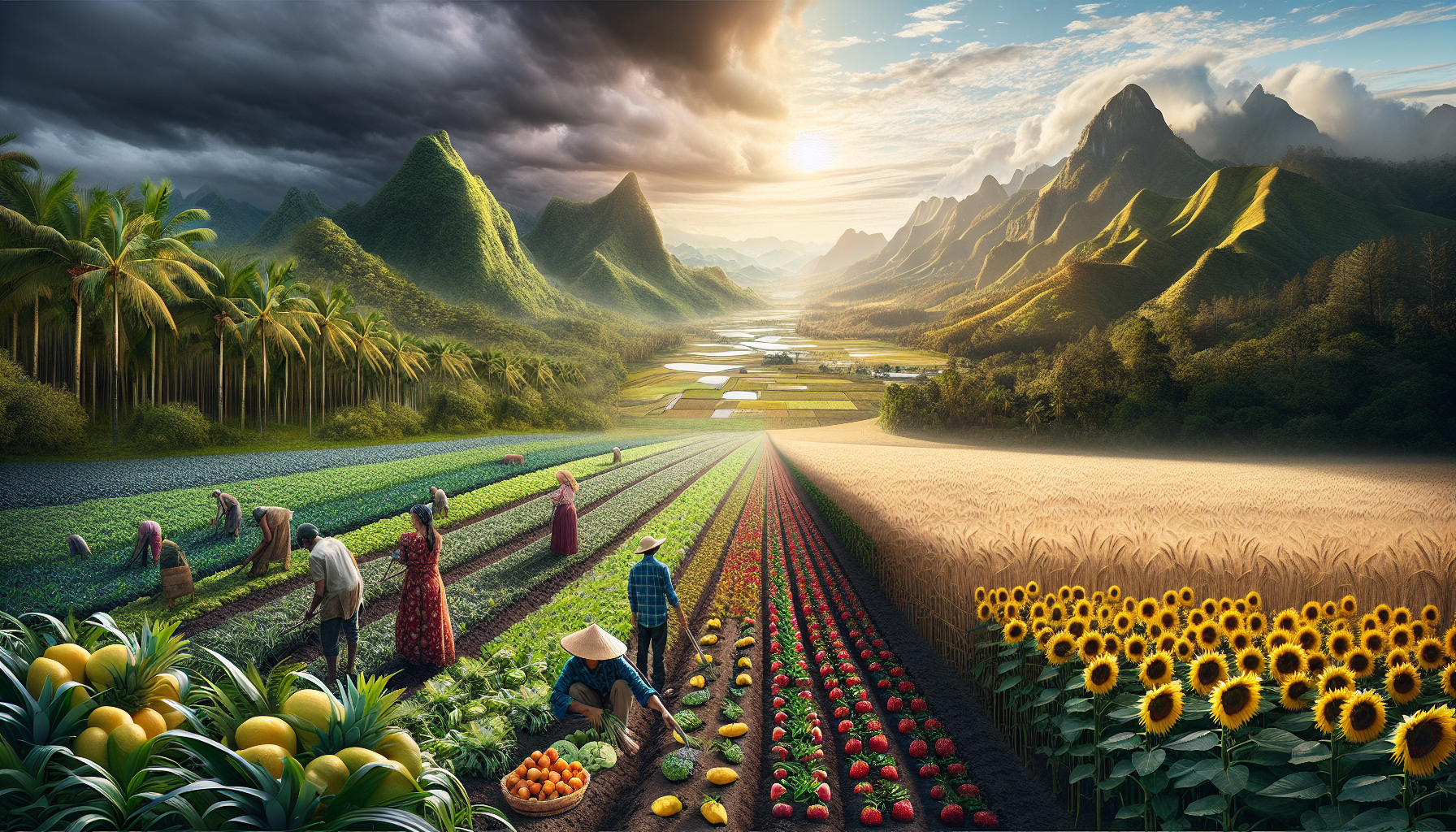In the not-so-distant past, the topic of climate change was often relegated to scientific journals and environmental documentaries. Today, it permeates daily conversations, news headlines, and social media feeds. As the planet experiences unprecedented shifts in weather patterns, rising temperatures, and more frequent extreme events, the impacts of climate change are undeniably vast and multifaceted. One of the most intriguing developments is its potential to redefine agricultural landscapes, pushing the boundaries of where and how we cultivate our food. This phenomenon, while challenging, also opens a window of opportunity for innovation and adaptation in agriculture. 🌾
At first glance, the effects of climate change on agriculture might seem daunting, with increased droughts, floods, and pests posing significant threats to crop yields. However, amid these challenges lies the potential for new cultivation zones to emerge in regions previously deemed unsuitable for farming. The warming of certain areas, paired with advancements in agricultural technology, creates a unique scenario where previously barren lands can transform into fertile fields. This shift not only holds promise for boosting food production but also for revitalizing rural economies and communities worldwide.
As we explore this dynamic interplay between climate change and agriculture, several key questions arise. How exactly are these new cultivation zones being identified and developed? What crops are best suited to these emerging environments? Moreover, what role does technology play in ensuring sustainable farming practices in these new areas? Throughout this article, we will delve into these questions, offering insights and case studies that highlight both the successes and challenges faced by farmers and scientists alike.
Furthermore, it’s essential to consider the socio-economic and environmental implications of expanding agricultural horizons. While the potential for increased food production is undoubtedly beneficial, it also raises questions about land use, biodiversity, and the displacement of existing ecosystems. Balancing these factors is critical to ensuring that the expansion of cultivation zones does not come at the expense of the planet’s health or the livelihoods of local communities. We will examine how stakeholders are navigating these complex issues, striving to create a harmonious relationship between agriculture and the environment. 🌍
In this journey through the evolving world of agriculture, we aim to shed light on the innovative approaches being employed to harness the opportunities presented by climate change. From precision farming and genetic crop improvements to collaborative efforts between governments, NGOs, and the private sector, the strategies being developed are as diverse as the landscapes they seek to transform. By the end of this article, you will gain a deeper understanding of how climate change is reshaping the agricultural map, and the potential it holds for creating a more resilient and sustainable global food system. Join us as we embark on this exploration of expanding horizons and the new frontiers of farming.
The Impact of Climate Change on Agricultural Zones
Climate change is undeniably one of the most pressing challenges of our time, affecting not only our environment but also the very fabric of human existence. Among the myriad of its impacts, a significant and often overlooked aspect is how it reshapes agricultural landscapes. As global temperatures rise, traditional farming zones are being altered, sometimes for the better, providing new opportunities for agriculture in regions previously unsuitable for cultivation. This expansion of potential agricultural zones due to climate change opens new doors for innovation and adaptation in the farming sector. 🌱
The shifting climate patterns lead to changes in precipitation, temperature, and the length of growing seasons. These factors are crucial for determining the viability of different crops in various regions. For example, areas that were once too cold for specific types of crops may now become hospitable, offering new agricultural prospects. Conversely, regions that were historically fertile might face challenges due to increased heat and water scarcity. Understanding these changes is essential for policymakers, farmers, and researchers to adapt effectively and mitigate potential negative impacts.
One of the remarkable outcomes of these shifts is the potential for agriculture to flourish in regions closer to the poles, such as Canada and Russia, which are experiencing longer and warmer growing seasons. However, this comes with the responsibility of managing these new zones sustainably. The need for sustainable practices is paramount to prevent further environmental degradation and ensure food security for the future. To grasp the full scope of these changes and their implications, it is crucial to delve into the dynamics of how climate change is reshaping agricultural zones globally.
How Climate Change is Reshaping Global Agriculture
Climate change is causing a shift in global temperature patterns, leading to both challenges and opportunities in agriculture. Traditionally cold regions are warming, providing new opportunities for cultivation. For instance, in Northern Europe and parts of North America, warmer temperatures are extending the growing season, allowing farmers to cultivate crops that were previously not viable in these regions. The ability to grow a wider variety of crops not only boosts local economies but also enhances food security by diversifying the types of crops that can be grown.
In contrast, regions already warm are experiencing increased stress on water resources and higher incidences of heatwaves. These conditions can lead to reduced yields and increased difficulty in maintaining traditional agricultural practices. Farmers in these areas are being forced to adapt by implementing more resilient farming practices, such as drought-resistant crops and improved irrigation techniques. The necessity for innovation and adaptation has never been more pressing as climate change continues to alter the agricultural landscape.
Another factor to consider is the impact on pest and disease distribution. Warmer temperatures can lead to the proliferation of pests and diseases that were previously limited by cooler climates. This shift can pose significant challenges to farmers, who must adapt their pest management strategies to cope with these changes. Therefore, understanding and predicting these shifts is vital for developing strategies that ensure sustainable and productive agriculture in the face of climate change.
Comparative Analysis of Emerging Cultivation Zones
To better understand the emerging cultivation zones, it is essential to compare different regions and their potential for agricultural expansion. Below is a table comparing the traditional and emerging agricultural zones, highlighting the changes in climate and the corresponding agricultural opportunities.
| Region | Traditional Climate | Emerging Climate | Agricultural Opportunities |
|---|---|---|---|
| Canada | Cold, Short Growing Season | Warmer, Longer Growing Season | Potential for more diverse crops like corn and soybeans |
| Northern Europe | Cool, Wet | Milder, Longer Growing Season | Increased wheat and barley production |
| Sub-Saharan Africa | Hot, Arid | Hotter, Drier | Need for drought-resistant crops |
The table above illustrates the transformative impact of climate change on agricultural zones. Canada and Northern Europe are experiencing more favorable conditions for agriculture due to warmer temperatures and extended growing seasons. In contrast, Sub-Saharan Africa faces the challenge of adapting to hotter and drier conditions, necessitating the development and adoption of resilient farming practices.
Opportunities and Challenges for Farmers
While climate change opens up new agricultural zones, it also presents a myriad of challenges for farmers. In emerging cultivation areas, there is a potential for economic growth and diversification of crops, which can enhance food security. However, farmers must navigate the complexities of new environmental conditions, including soil quality, pest and disease management, and water availability.
One of the main opportunities is the potential to grow high-value crops in regions where they were previously unfeasible. This not only boosts local economies but also supports global food security by increasing the supply of various crops. For instance, wine production in regions like England is expected to rise as warmer temperatures create more suitable conditions for vineyards. Similarly, the cultivation of crops such as maize and soybeans is becoming increasingly viable in Canada, opening new markets and revenue streams for farmers.
However, these opportunities come with challenges. Farmers must invest in new technologies and farming techniques to capitalize on these changing conditions. This includes adopting precision agriculture technologies to optimize resource use, employing sustainable practices to protect the environment, and developing strategies to cope with the increased threat of pests and diseases. Furthermore, the unpredictability of climate change necessitates continuous adaptation and resilience-building within the agricultural sector.
For more insights into how farmers are adapting to these changes, watch the informative video below:
Climate Change and Agriculture: Adapting to a New Reality – Channel: National Geographic
Technological Innovations Driving Adaptation
To address the challenges posed by climate change, technological innovation is playing a crucial role in helping farmers adapt to new cultivation zones. Precision agriculture, for instance, involves the use of data analytics, sensors, and GPS technology to optimize farming practices, improve crop yields, and reduce resource waste. By leveraging these technologies, farmers can make informed decisions about planting, irrigation, and pest control, thereby enhancing productivity and sustainability.
Another significant innovation is the development of climate-resilient crop varieties. Advances in biotechnology have led to the creation of crops that can withstand extreme weather conditions, resist pests and diseases, and thrive in less fertile soils. These resilient crops are essential for ensuring food security in regions facing adverse climatic conditions.
In addition to technological advancements, there is a growing emphasis on regenerative agriculture practices. These practices focus on restoring soil health, enhancing biodiversity, and improving water management. By adopting regenerative agriculture, farmers can build more resilient agricultural systems that are better equipped to withstand the impacts of climate change.
Socio-Economic Implications of Expanding Cultivation Zones
The expansion of cultivation zones due to climate change has significant socio-economic implications. On one hand, it presents opportunities for rural development, job creation, and economic growth in newly viable agricultural regions. As new markets emerge, there is potential for increased trade and investment, benefiting both local communities and the global economy.
However, these changes can also exacerbate existing inequalities. Farmers in developing regions may lack access to the necessary resources and technologies to adapt effectively, putting them at a disadvantage compared to their counterparts in more developed areas. This disparity highlights the need for supportive policies and international cooperation to ensure that all farmers have the tools and knowledge needed to thrive in a changing climate.
The socio-economic landscape of agriculture is being reshaped by climate change, necessitating a comprehensive approach to address both the opportunities and challenges it presents. By fostering collaboration and innovation, we can harness the potential of expanding cultivation zones to build a more sustainable and equitable future for global agriculture.
- Explore how climate change is creating new opportunities for agriculture in your region.
- Learn about precision agriculture technologies that can help optimize farming practices.
- Discover the potential of climate-resilient crops to enhance food security.

Conclusion
Expanding Horizons: Climate Change Creates New Cultivation Zones for Agriculture
In conclusion, this exploration into how climate change is reshaping agricultural landscapes offers a comprehensive understanding of both challenges and opportunities. Throughout the article, we have examined the fundamental shifts in climate patterns, the opening of new cultivation zones, and the implications these changes hold for global food security. Let’s revisit the key points discussed, highlighting the crucial takeaways and reinforcing the significance of adapting agricultural practices in this evolving environment.
Initially, we delved into the scientific underpinnings of climate change and its direct impact on agriculture. The article outlined how rising global temperatures and shifting precipitation patterns are altering traditional growing seasons, pushing cultivation zones toward higher altitudes and latitudes. This shift poses a dual challenge: while some regions may benefit from new agricultural opportunities, others face increased vulnerability due to extreme weather events and soil degradation.
Furthermore, we explored the emergence of new cultivation zones as a potential boon for global agriculture. Areas previously unsuitable for farming are now witnessing viable growing conditions for various crops. For instance, parts of northern Europe, Canada, and Russia are experiencing longer growing seasons, enabling the cultivation of crops like wheat, barley, and even wine grapes. However, the transition to farming these new zones is not without its hurdles, including the need for infrastructure development, investment in research, and addressing socio-economic impacts on local communities.
The article also shed light on the technological and sustainable practices that can mitigate the adverse effects of climate change on agriculture. Innovations such as precision farming, drought-resistant crop varieties, and regenerative agriculture are playing crucial roles in adapting to new climatic realities. These advancements not only boost productivity but also promote environmental sustainability by preserving soil health and reducing greenhouse gas emissions.
Another key point discussed is the socio-economic dimension of these shifts. As climate change reshapes agricultural boundaries, it creates a ripple effect on rural economies and global trade patterns. Farmers in newly arable regions must navigate market access, financial investment, and policy support to capitalize on these opportunities. Simultaneously, there is a pressing need for international cooperation and policy frameworks that ensure equitable resource distribution and protect vulnerable communities from being left behind.
The importance of addressing these changes cannot be overstated. As climate change continues to redefine agricultural landscapes, the global community must prioritize adaptive strategies that bolster food security and economic resilience. Investing in research, fostering innovation, and implementing policies that support sustainable agriculture are crucial steps toward a resilient future.
As we conclude this article, it is essential to acknowledge that the path forward requires collective action and collaboration across sectors. The agriculture industry, policymakers, researchers, and consumers all play pivotal roles in shaping the future of farming in a changing climate. By staying informed and actively participating in discussions around climate-resilient agriculture, we can work toward solutions that benefit both people and the planet.
We encourage you to reflect on the insights shared here and consider how they may impact your perspective or professional endeavors. Sharing knowledge and experiences can lead to innovative solutions and inspire others to take action. Please feel free to leave your comments below, engage in discussions, or share this article with your network to spread awareness about the evolving agricultural landscape.
Moreover, let’s embrace the potential of these new cultivation zones by supporting policies that encourage sustainable agricultural practices, investing in research and technology, and fostering global cooperation. Together, we can navigate the challenges of climate change and seize the opportunities it presents for a more sustainable and food-secure future. 🌱
For further reading, you can explore these active resources:
– NASA Climate Change and Agriculture
– FAO: Climate Change and Food Security
– IPCC: Climate Change and Land
Thank you for joining us on this journey to understand how climate change is reshaping the world of agriculture. Let’s continue to expand our horizons and cultivate a better future for generations to come.
Toni Santos is a visual storyteller and botanical artisan whose creations explore the wild elegance of carnivorous and exotic plants. With a deep reverence for nature’s most mysterious flora, Toni captures the untamed beauty of insect-eating mechanisms, alien-like blooms, and resilient life thriving in extreme environments.
Rooted in a lifelong fascination with the strange intelligence of plants, his work blends science, symbolism, and storytelling. From the snap of a Venus flytrap to the labyrinthine curves of a Nepenthes pitcher, each piece Toni creates reveals a deeper narrative — one of survival, adaptation, and the subtle power of nature’s most unexpected designs.
With a background in visual design and handcrafted artistry, Toni merges technique with intention, crafting illustrations, collections, and visual studies that not only depict these botanical wonders — but evoke their hidden magic. His inspiration often comes from ancient lore, natural history, and the eerie elegance of ecosystems where these plants thrive.
As the creative force behind Vizovex, Toni shares this botanical fascination with the world, offering curated artwork, stories, and pieces that help others reconnect with nature’s wilder, more enigmatic side.
His work is a tribute to:
The fierce beauty of carnivorous plants
The visual language of adaptation and survival
The mysteries of exotic flora in forgotten habitats
Whether you’re a plant enthusiast, a science lover, or someone drawn to the strange and beautiful, Toni welcomes you into a world where every leaf hides a secret — one trap, one tendril, one story at a time.




